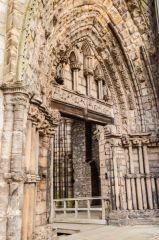
Sometime in the late 12th century the original church was rebuilt on a lavish scale, which eventually stretched to a nave of 8 bays punctuated with west towers. There were both north and south transepts of two bays, and an aisled choir of 6 bays. In addition, there was a lady chapel and an east chapel aisle.
Scottish monarchs often used the abbey for solemn occasions; James II, III, and IV were married at Holyrood Abbey, and both James V and Charles I were crowned here. In 1544 the abbey was sacked and burned by English troops under the Earl of Hertford. No sooner had the monks recovered than the English were back again, burning and looting the abbey in 1547. In 1570 the transepts and choir were destroyed, but the nave was repaired to roughly the state we see it in now.
In 1688 a mob celebrating the accession of the Protestant William of Orange to the throne of England broke into the abbey, opened the royal vaults, and broke into several royal tombs. Among other acts of desecration, Lord Darnley's head was removed from his tomb. A new roof was put on in 1758, but this collapsed in 1768 and the abbey was left to moulder away, creating the enticing, atmospheric ruins we see today.
Visiting
As mentioned, the only way to visit the abbey is by purchasing admission to the Palace of Holyrood House, which is well worth visiting in its own right! The abbey comes at the very end of the Palace tour. Not much has survived the passage of time and depredations of the English, but there is one vaulted aisle, and the main, roofless section of the abbey church to see. One highlight that is very easy to miss is at the east end, where a plain rectangular vault stands, marked by a simple plaque, with an iron-studded wooden door set into the vault wall.This vault was built after the English destroyed the royal vaults in 1544. The coffins of James V, his first wife Magdalen, and his infant sos by Mary of Guise were interred here. Their bones were disturbed in the riots of 1688. In 1898 Queen Victoria ordered the vault repaired, and the bones reburied, along with the coffin of Mary of Gueldres, queen to James II, whose remains came here in 1848 from Trinity Church.
When you leave the abbey church, look back, for the west front is wonderfully carved with figures, and the doorway arch is a work of art. For another view of the abbey, take the path through the Palace gardens, which curves around behind the abbey church. From the path you can see foundations of more abbey buildings in the grass.
Connected to Holyrood Abbey is a three-storey building on Abbey Strand, dating to the late 15th or early 16th century. The building was partly rebuilt in 1544 and restored in 1916.







 We've 'tagged' this attraction information to help you find related historic attractions and learn more about major time periods mentioned.
We've 'tagged' this attraction information to help you find related historic attractions and learn more about major time periods mentioned.

